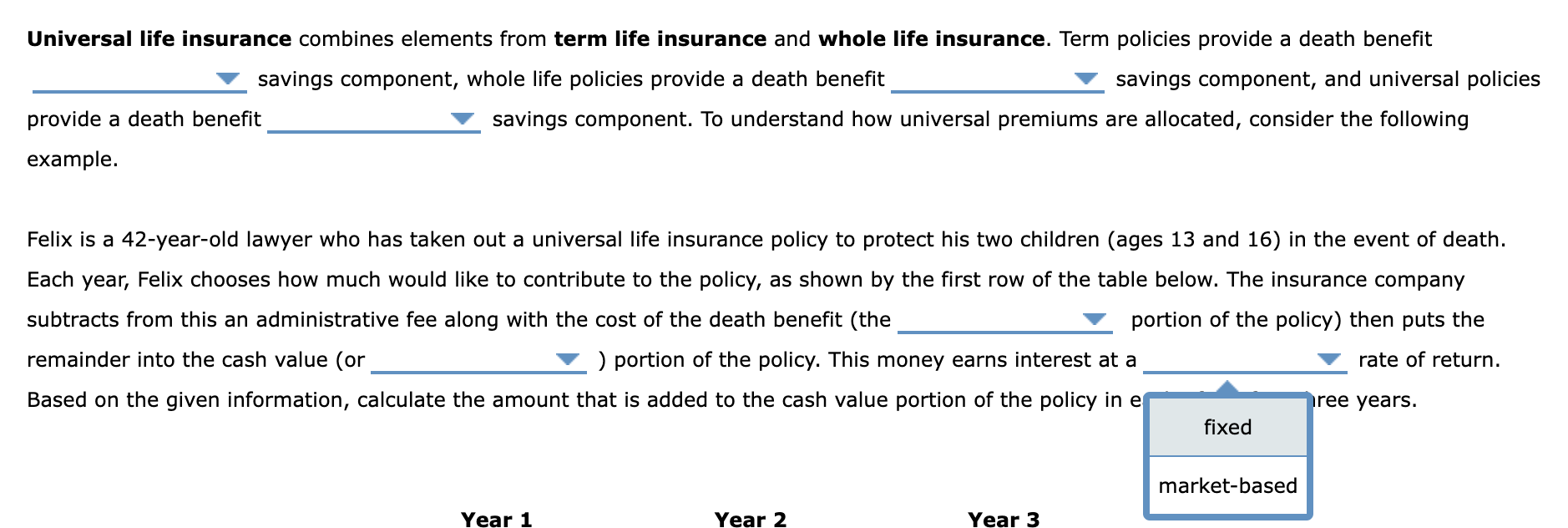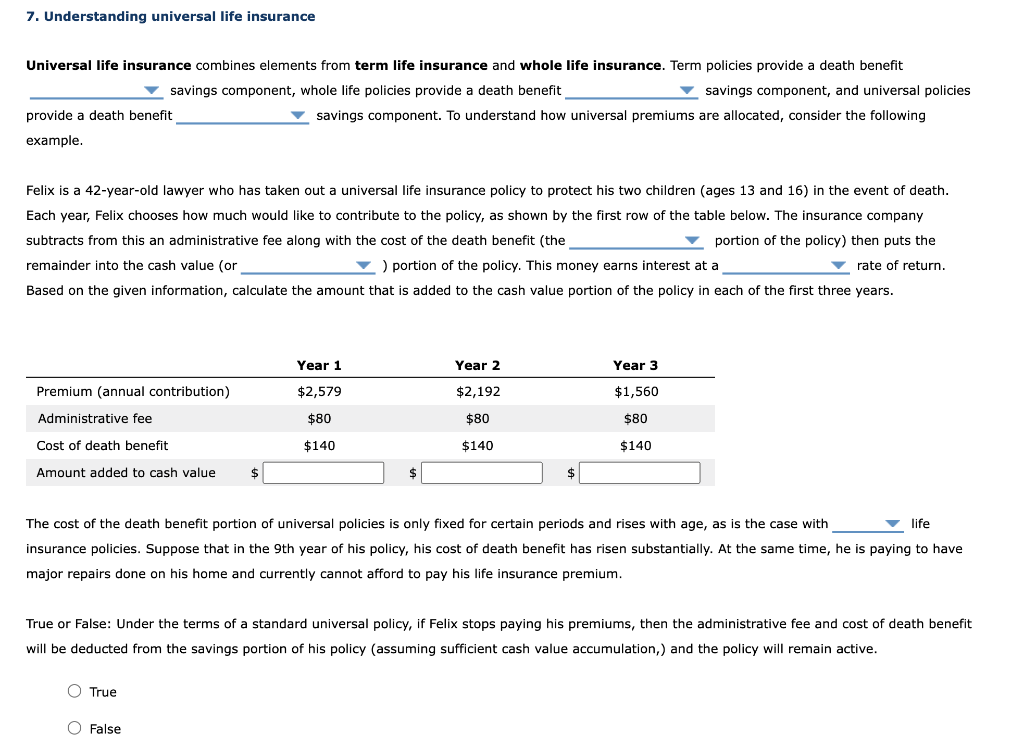







Universal life insurance combines elements from term life insurance and whole life insurance. Term policies provide a death benefit savings component, whole life policies provide a death benefit savings component, and universal policies nefit savings component. To understand how universal premiums are allocated, consider the following Id lawyer who has taken out a universal life insurance policy to protect his two children (ages 13 and 16) in the event of death. oses how much would like to contribute to the policy, as shown by the first row of the table below. The insurance company subtracts from this an administrative fee along with the cost of the death benefit (the portion of the policy) then puts the remainder into the cash value (or ) portion of the policy. This money earns interest at a rate of return. Based on the given information, calculate the amount that is added to the cash value portion of the policy in each of the first the Universal life insurance combines elements from term life insurance and whole life insurance. Term policies provide a death benefit savings component, whole life policies provide a death benefit savings component, and universal policies provide a death benefit savings component. To understand how ns are allocated, consider the following example. Felix is a 42-year-old lawyer who has taken out a universal life insurance policy to pre 13 and in the event of death. Each year, Felix chooses how much would like to contribute to the policy, as shown by le table below. The insurance company subtracts from this an administrative fee along with the cost of the death benefit (the portion of the policy) then puts the remainder into the cash value (or ) portion of the policy. This money earns interest at a rate of return. Based on the given information, calculate the amount that is added to the cash value portion of the policy in each of the first three years. Universal life insurance combines elements from term life insurance and whole life insurance. Term policies provide a death benefit savings component, whole life policies provide a death benefit savings component, and universal policies provide a death benefit savings component. To understand how universal premiums are allocated, consider the following example. Felix is a 42-year-old la !n out a universal life insurance policy to protect his two children (ages 13 and 16) in the event of death. Each year, Felix chooses like to contribute to the policy, as shown by the first row of the table below. The insurance company subtracts from this an a along with the cost of the death benefit (the portion of the policy) then puts the remainder into the cash value (or ) portion of the policy. This money earns interest at a rate of return. Based on the given information, calculate the amount that is added to the cash value portion of the policy in each of the first three yers. Universal life insurance combines elements from term life insurance and whole life insurance. Term policies provide a death benefit savings component, whole life policies provide a death benefit savings component, and universal policies provide a death benefit savings component. To understand how universal premiums are allocated, consider the following example. Felix is a 42-year-old lawyer who has taken out a universal life insurance policy to protect his two children (ages 13 and 16 ) in the event of death. Each year, Felix chooses how much would like to contribute to the policy, as shown by the first row of the table below. The insurance company subtracts from this an administrative fee along with the cost of the death benefit (the portion of the policy) then puts the remainder into the cash value (or ) portion of the policy. This m it at a rate of return. Based on the given information, calculate the amount that is added to the cash value zy in each of the first three years. Universal life insurance combines elements from term life insurance and whole life insurance. Term policies provide a death benefit savings component, whole life policies provide a death benefit savings component, and universal policies provide a death benefit savings component. To understand how universal premiums are allocated, consider the following example. Felix is a 42-year-old lawyer who has taken out a universal life insurance policy to protect his two children (ages 13 and 16 ) in the event of death. Each year, Felix chooses how much would like to contribute to the policy, as shown by the first row of the table below. The subtracts from this an administrative fee along with the cost of the death benefit (the portion of the policy) then puts the remainder into the cash value (or ) portion of the policy. This money earns interest at a rate of return. Based on the given information, c it that is added to the cash value portion of the policy in each of the first three years. Year 2 Year 3 Universal life insurance combines elements from term life insurance and whole life insurance. Term policies provide a death benefit savings component, whole life policies provide a death benefit savings component, and universal policies provide a death benefit savings component. To understand how universal premiums are allocated, consider the following example. Felix is a 42-year-old lawyer who has taken out a universal life insurance policy to protect his two children (ages 13 and 16 ) in the event of death. Each year, Felix chooses how much would like to contribute to the policy, as shown by the first row of the table belows insurance company subtracts from this an administrative fee along with the cost of the death benefit (the portion of the policy) then puts the remainder into the cash value (or ) portion of the policy. This money earns interest at a rate of return. Based on the given information, calculate the amount that is added to the cash value portion of the policy in e ree years. The cost of the death benefit portion of universal policies is only fixed for certain periods and rises with age, as is the case with life insurance policies. Suppose that in the 9th year of his policy, his cost of death benefit has risen substantially. At the same time, major repairs done on his home and currently cannot afford to pay his life insurance premium. True or False: Under the terms of a standard universal policy, if Felix stops paying his premiums, then the administrative fee anc cusc death benefit will be deducted from the savings portion of his policy (assuming sufficient cash value accumulation,) and the policy will remain active. True False 7. Understanding universal life insurance Universal life insurance combines elements from term life insurance and whole life insurance. Term policies provide a death benefit savings component, whole life policies provide a death benefit savings component, and universal policies provide a death benefit savings component. To understand how universal premiums are allocated, consider the following example. Felix is a 42-year-old lawyer who has taken out a universal life insurance policy to protect his two children (ages 13 and 16 ) in the event of death. Each year, Felix chooses how much would like to contribute to the policy, as shown by the first row of the table below. The insurance company subtracts from this an administrative fee along with the cost of the death benefit (the portion of the policy) then puts the remainder into the cash value (or ) portion of the policy. This money earns interest at a rate of return. Based on the given information, calculate the amount that is added to the cash value portion of the policy in each of the first The cost of the death benefit portion of universal policies is only fixed for certain periods and rises with age, as is the case with life insurance policies. Suppose that in the 9th year of his policy, his cost of death benefit has risen substantially. At the same time, he is paying to have major repairs done on his home and currently cannot afford to pay his life insurance premium. True or False: Under the terms of a standard universal policy, if Felix stops paying his premiums, then the administrative fee and cost of death benefit will be deducted from the savings portion of his policy (assuming sufficient cash value accumulation, ) and the policy will remain active. True False














